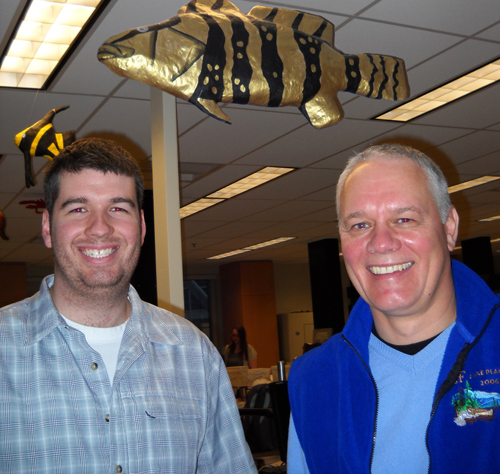
U of G studies of one of Ontario’s oldest and longest-lived natives may ultimately help in rescuing threatened lake sturgeon from extinction, says Prof. Rob McLaughlin, Integrative Biology. But in a classic example of the tradeoffs faced by resource managers, he says efforts to protect native sturgeon could undermine costly and longtime efforts to control invasive sea lamprey that threaten fish in the Great Lakes.
That dilemma surfaces in a master’s thesis defended this fall by Eric Smyth, now working in McLaughlin’s lab as a research assistant. Smyth hopes his study of several fish species on the Black Sturgeon River north of Lake Superior will help managers weighing control of invaders and rehabilitation of native organisms there and in other parts of the Great Lakes.
One thing is clear, says Smyth. Referring to competing interests from sport fishers to environmental groups to government agencies, he says, “There is no simple way to resolve tradeoffs. No matter what, there’s going to be some negative consequences to management.”
Ancestors of sturgeon lived millions of years before modern humans arrived on Earth. Today all 27 species of this ancient fish, including Ontario lake sturgeon, are on the “threatened” list of the International Union for Conservation of Nature, according to an article in On Nature magazine published last fall by Toronto-based Ontario Nature.
That article blames overfishing and hydro dams rather than invasive species for the decline of lake sturgeon. Today commercial and recreational fishing of sturgeon is banned. But under provincial green energy rules, companies have filed proposals to build new hydroelectric dams on rivers around the Great Lakes.
Those plans have raised new worries about the sturgeon’s fate. Many of the adults migrate far upstream to spawn in river shallows. Dams may impede their passage or alter their breeding areas. Quoted in the On Nature story, McLaughlin says, “Sturgeon are a big fish and they’re highly mobile. If you put in a dam….You’re going to fragment the population.”
Adult sturgeon can reach two to three metres in length and weigh more than 150 kilograms. They are also long-lived, with some more than a century old.
The U of G study outlines three management options for a dam built in 1960 on the Black Sturgeon River. The dam was built initially to control water levels and later modified to thwart sea lamprey. These parasitic fish entered the Great Lakes in the early 20th century and prey on many native species.
Lamprey control involving dams, chemical treatments and other methods started in the mid-1900s; Canada and the United States created the Great Lakes Fishery Commission (GLFC) to run that control program in all five lakes.
McLaughlin has served on that group’s task forces on lamprey control. He came to Guelph in 2002 under a GLFC-funded ecosystem program.
Smyth looked at different options affecting not just lake sturgeon but other fishes.
Leaving the dam in place would continue to pose a barrier not just for sturgeon attempting to reach spawning areas but for walleye. Installing a fishway system at the dam would allow sturgeon and walleye through while halting lamprey, although perhaps not as effectively. Finally, moving the dam upstream would require chemical sea lamprey treatment that might in turn threaten native northern brook lamprey. (McLaughlin has studied effects of lamprey control on other species.)
Referring to varied species – and numerous groups involved on the Black Sturgeon River – McLaughlin says, “It’s a real mess.”
Smyth used literature data and crunched scenarios, including estimates of fish numbers, spawning and survival rates and projected effects of various control options. Rather than promote a particular option – and risk being seen as favouring one competing group over another – he says his thesis discusses those choices and offers managers a new quantitative model for weighing management of native and invasive species around the Great Lakes basin.
Agencies and groups are still weighing their options. McLaughlin says it’s important to consider numerous factors involving tradeoffs between renewable resources and between natives and invaders.
He hopes to continue studies on the Black Sturgeon River, where he says more research is needed on testing release of both walleye and sturgeon above the dam. That might give managers an idea of how well they reproduce and possible impacts of new dam control options.
Originally from Burlington, Ont., Smyth brought interests in fisheries conservation to his grad studies at Guelph. A summer job with Fisheries and Oceans Canada led him to his master’s co-adviser, Marten Koops, a research scientist at the Great Lakes Laboratory for Fisheries and Aquatic Sciences in Burlington.